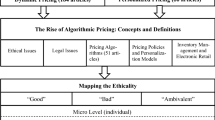Abstract
The lottery payoff procedure does not successfully induce risk-neutral bidding behavior in first-price, sealedbid auctions. This conclusion follows from both ordinary-least-squares estimation with natural data and leastabsolute-deviation estimation with transformed data from numerous experimental designs. Lottery payoffs do not succeed in inducing behavior predicted from standard expected utility theory assumptions or from assumed utility from winning and/or income thresholds. In contrast, first-price auction experiments with monetary payoffs yield results that are consistent with general models of bidding in the independent private values information environment.
Similar content being viewed by others
References
Berg, Joyce E., Lane A. Daley, John W. Dickhaut, and John R. O'Brien. (1986). “Controlling Preferences for Lotteries on Units of Experimental Exchange,”Quarterly Journal of Economics 101, 281–306.
Conover, W. J. (1980).Practical Nonparametric Statistics. New York: John Wiley & Sons.
Cooper, Russell W., Douglas V. DeJong, Robert Forsythe, and Thomas W. Ross. (1989). “Communication in Battle-of-the-Sexes Games: Some Experimental Results,”Rand Journal of Economics 20, 568–587.
Cox, James C., and Ronald L. Oaxaca. (1995). “Is Bidding Behavior Consistent with Bidding Theory for Private Value Auctions?” In R. Mark Isaac (ed.),Research in Experimental Economics, Vol. 6. Greenwich: JAI Press, forthcoming.
Cox, James C., Bruce Roberson, and Vernon L. Smith. (1982). “Theory and Behavior of Single Object Auctions.” In V. L. Smith(ed.),Research in Experimental Economics, Vol. 2. Greenwich: JAI Press.
Cox, James C., Vernon L. Smith, and James M. Walker. (1982). “Auction Market Theory of Heterogeneous Bidders,”Economics Letters 9, 319–32.
Cox, James C., Vernon L. Smith, and James M. Walker. (1985). “Experimental Development of Sealed-Bid Auction Theory: Calibrating Controls for Risk Aversion,”American Economic Review, Papers and Proceedings 7, 160–16.
Cox, James C., Vernon L. Smith, and James M. Walker. (1988). “Theory and Individual Behavior of First-Price Auctions,”Journal of Risk and Uncertainty 1, 61–99.
Judge, George G., William E. Griffiths, R. Carter Hill, and Tsoung-Chao Lee. (1980).The Theory and Practice of Econometrics. New York: John Wiley & Sons.
Judge, George G., and Thomas A. Yancey. (1986).Improved Methods of Inference in Econometrics. New York: North-Holland.
Powell, J. L. (1984). “Least Absolute Deviations Estimation for the Censored Regression Model,”Journal of Econometrics 2, 303–32.
Rietz, Thomas A. (1992). “Controlling Risk Preferences: Some Results for Experimental Sealed Bid Auctions.” Working Paper No. 71, Department of Finance, Kellogg Graduate School of Management, North-western University.
Rietz, Thomas A. (1993). “Implementing and Testing Risk Preference Induction Mechanisms in Experimental Sealed Bid Auctions,”Journal of Risk and Uncertainty 7, 199–213.
Vickrey, William. (1961). “Counterspeculation, Auctions, and Competitive Sealed Tenders,”Journal of Finance 16, 8–27.
Walker, James M., Vernon L. Smith, and James C. Cox. (1990). “Inducing Risk-Neutral Preferences: An Examination In a Controlled Market Environment,”Journal of Risk and Uncertainty 3, 5–24.
Author information
Authors and Affiliations
Rights and permissions
About this article
Cite this article
Cox, J.C., Oaxaca, R.L. Inducing risk-neutral preferences: Further analysis of the data. J Risk Uncertainty 11, 65–79 (1995). https://doi.org/10.1007/BF01132731
Issue Date:
DOI: https://doi.org/10.1007/BF01132731




